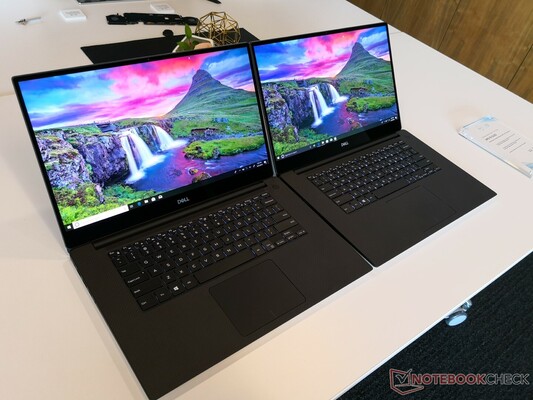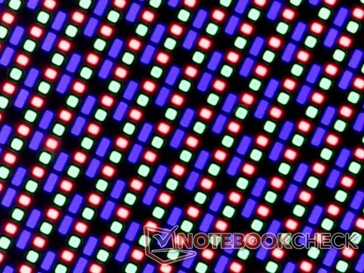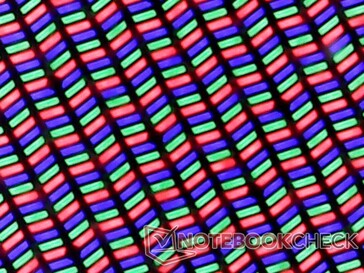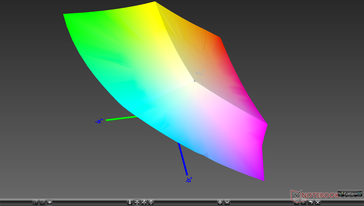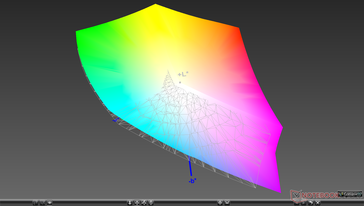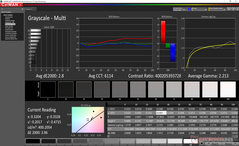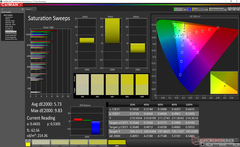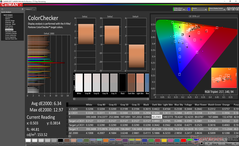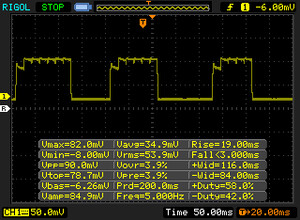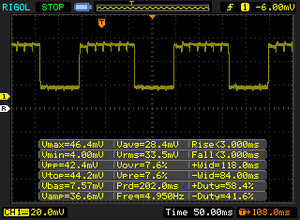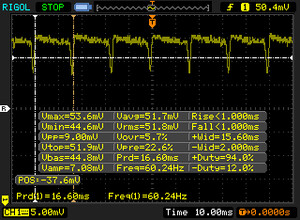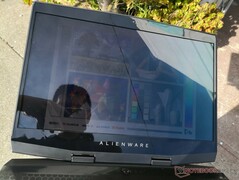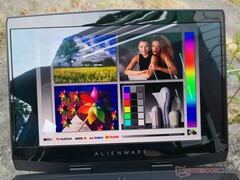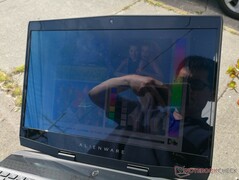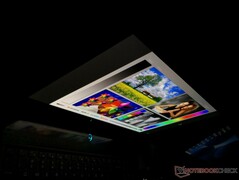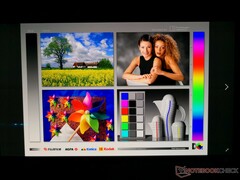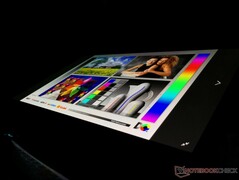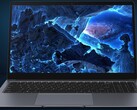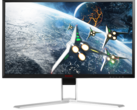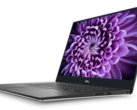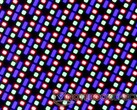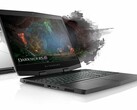Looking to buy an OLED laptop this year? Here's what you need to know
Introduction
Update: 05/07/2019 — added correction of a 6-hour difference in battery life between UHD and OLED 4K panels for the XPS 15
Update: 04/07/2019 — added note in conclusion about battery life; edited information on PWM
After a slow start and then year-long hiatus, OLED is back and being positioned as a premium display option by many major manufacturers. This display technology offers benefits that even the best TN and IPS panels can't touch for now: no screen bleeding, extremely high contrast levels, and minuscule (<3ms grey-to-grey and black-to-white) response times. However, OLED panels do have their share of drawbacks, and this article aims to provide consumers with an in-depth look at the exact panel model you'll end up with if you buy an OLED laptop this year as well as compare it to the best of the competition.
That's because we've learned from industry sources that the main (and possibly only) OLED panel being used for 15-inch laptops is the Samsung SDCA029. This 15.6-inch, 16:9, 3840 x 2160 pixel (4k/UHD), glossy, non-touch display is going to be showing up on likely every laptop offering an OLED option through this year and into the next: It going to be featured on laptops like the Dell XPS 15 7590, Alienware m15, G7 15, HP Spectre x360 15, Lenovo ThinkPad P1 Gen 2, Gigabyte Aero 15, Razer Blade 15, Sager, and more.
Luckily, we've been able to test this panel extensively in our Alienware m15 P79F review: With this data, we are able to offer a comprehensive analysis of this soon-to-be ubiquitous OLED panel to help you make an informed decision on whether you want to go OLED in 2019 or not.
The Samsung SDCA029 — Brightness distribution, subpixel array, and comparisons
As mentioned in the introduction, OLED has some tantalizing advantages. The Samsung SDCA029 (156WR04 is the identifier for the AW m15 system, but other identifier numbers still seem to be the same exact panel from Samsung) makes a strong first impression with its high (UHD) resolution, strong brightness, vibrant colors, and inky blacks. Unlike some of its fast-TN or premium IPS competition, this panel is limited to a 60Hz refresh rate and lacks touch functionality, however.
The average brightness of 451 cd/m² of this panel is impressive and is only rivaled or eclipsed by the recent Apple MacBook Pros and HP EliteBooks (for a list of our best notebook displays, click here). Although IPS glow and backlight bleeding are issues that OLED manages to avoid, that does not mean that this panel is able to achieve flawless distribution of brightness. There is a delta of up to 48 cd/m² present on our test system (maximum 472.4 nits vs. a minimum of 424.2) as seen below in the brightness distribution map. This is not the worst we've seen by a long shot (it's significantly better than the Sharp UHD panel on the XPS 15 9570 seen in the table below), but it is shy of the 20 cd/m² delta seen in the Apple MacBook Pro 13 2018. It is possible you might notice the unevenness with bright and solid color backgrounds if you are looking for it.
Looking more closely, you will note that the subpixel array of the Samsung SDCA029 has a markedly different appearance to that of the otherwise similar (in UHD resolution and DPI) IPS panel found on the XPS 15 9570. The different appearance of the OLED pixel array (with its larger blue subpixels) is to account for the variance between the degradation rates for the differently coloured subpixels. Blue subpixels are known to degrade at a faster rate than red or green — another drawback of the technology. This subpixel arrangement allows the blues to be less bright than red or green subpixels, which should prolong the life of the panel with less colour shifting.
The comparison table below pits the Samsung SDCA029 against some of the best displays to top our charts as well as the Razer Blade 15's LGD05C0 144 Hz panel (for response time comparison).
| |||||||||||||||||||||||||
Brightness Distribution: 90 %
Center on Battery: 452.1 cd/m²
Contrast: ∞:1 (Black: 0 cd/m²)
ΔE ColorChecker Calman: 6.34 | ∀{0.5-29.43 Ø4.78}
ΔE Greyscale Calman: 2.8 | ∀{0.09-98 Ø5}
100% sRGB (Argyll 1.6.3 3D)
91% AdobeRGB 1998 (Argyll 1.6.3 3D)
100% AdobeRGB 1998 (Argyll 3D)
100% sRGB (Argyll 3D)
99.9% Display P3 (Argyll 3D)
Gamma: 2.21
CCT: 6114 K
| Alienware m15 P79F Samsung SDCA029, 156WR04, OLED, 15.6", 3840x2160 | Gigabyte Aero 15-Y9 AU Optronics B156ZAN03.1 (AUO31EB), IPS, 15.6", 3840x2160 | Apple MacBook Pro 15 2018 (2.6 GHz, 560X) APPA040, IPS, 15.4", 2880x1800 | Razer Blade 15 RTX 2080 Max-Q Sharp LQ156M1JW03 (SHP14C5), IPS, 15.6", 1920x1080 | Dell XPS 15 9570 Core i9 UHD LQ156D1, IPS, 15.6", 3840x2160 | Apple iPad Pro 12.9 2018 IPS, 12.9", 2732x2048 | |
|---|---|---|---|---|---|---|
| Display | -4% | -5% | -22% | -14% | ||
| Display P3 Coverage (%) | 99.9 | 86.8 -13% | 98.7 -1% | 66.9 -33% | 79.6 -20% | |
| sRGB Coverage (%) | 100 | 100 0% | 99.9 0% | 98.1 -2% | 98.4 -2% | |
| AdobeRGB 1998 Coverage (%) | 100 | 99.7 0% | 86.6 -13% | 68.5 -31% | 79.7 -20% | |
| Response Times | -1680% | -1410% | -372% | -1595% | -1359% | |
| Response Time Grey 50% / Grey 80% * (ms) | 2.6 ? | 60 ? -2208% | 43.2 ? -1562% | 12.8 ? -392% | 52.4 ? -1915% | 49.6 ? -1808% |
| Response Time Black / White * (ms) | 2.3 ? | 28.8 ? -1152% | 31.2 ? -1257% | 10.4 ? -352% | 31.6 ? -1274% | 23.2 ? -909% |
| PWM Frequency (Hz) | 60.2 ? | 117000 ? | 23810 ? | 1000 ? | ||
| Screen | 23% | 40% | 7% | -28% | 46% | |
| Brightness middle (cd/m²) | 452.1 | 350 -23% | 520 15% | 293 -35% | 451.9 0% | 632 40% |
| Brightness (cd/m²) | 452 | 337 -25% | 492 9% | 270 -40% | 414 -8% | 605 34% |
| Brightness Distribution (%) | 90 | 92 2% | 88 -2% | 87 -3% | 81 -10% | 91 1% |
| Black Level * (cd/m²) | 0.29 | 0.39 | 0.29 | 0.36 | 0.32 | |
| Colorchecker dE 2000 * | 6.34 | 0.93 85% | 1.2 81% | 1.69 73% | 5.62 11% | 1.1 83% |
| Colorchecker dE 2000 max. * | 12.97 | 1.43 89% | 2.3 82% | 3.37 74% | 19.1 -47% | 2.4 81% |
| Greyscale dE 2000 * | 2.8 | 1.21 57% | 1.3 54% | 2.3 18% | 6.9 -146% | 1.7 39% |
| Gamma | 2.21 100% | 2.2 100% | 2.18 101% | 2.3 96% | 2.2 100% | 2.21 100% |
| CCT | 6114 106% | 6672 97% | 6738 96% | 6758 96% | 6254 104% | 6794 96% |
| Color Space (Percent of AdobeRGB 1998) (%) | 91 | 88 -3% | 63 -31% | 71.8 -21% | ||
| Color Space (Percent of sRGB) (%) | 100 | 100 0% | 98.5 -1% | 98.5 -1% | ||
| Contrast (:1) | 1207 | 1333 | 1010 | 1255 | 1975 | |
| Colorchecker dE 2000 calibrated * | 0.62 | 1.24 | 2.69 | |||
| Total Average (Program / Settings) | -554% /
-245% | -458% /
-236% | -129% /
-58% | -546% /
-266% | -657% /
-305% |
* ... smaller is better
As evidenced by the comparison table above, the SDCA029 holds its own in brightness, brightness distribution, gamma, and colour space. Most notably its 2.6 ms grey-to-grey and 2.3 ms black-to-white response times put the other panels to shame — even the 144 Hz Sharp, with a 12.8 ms GtG and 10.4 ms BtW response time. Prospective gaming enthusiasts should be aware that despite the slightly slower response times, a 144 Hz IPS panel like the Sharp LQ156M1JW03 will always be superior for fast-paced gaming over a 60 Hz OLED panel, however.
As noted in our Alienware 15 review, the Samsung's OLED panel's colour space encompasses the wide-gamut DCI-P3 standard, putting it in rare comparison with the MacBook Pro. Once properly calibrated (and HDR turned off), this panel should be excellent for colour-accurate work such as professional film and video editing.
Display Response Times
| ↔ Response Time Black to White | ||
|---|---|---|
| 2.3 ms ... rise ↗ and fall ↘ combined | ↗ 1 ms rise | |
| ↘ 1.3 ms fall | ||
| The screen shows very fast response rates in our tests and should be very well suited for fast-paced gaming. In comparison, all tested devices range from 0.1 (minimum) to 240 (maximum) ms. » 11 % of all devices are better. This means that the measured response time is better than the average of all tested devices (20.2 ms). | ||
| ↔ Response Time 50% Grey to 80% Grey | ||
| 2.6 ms ... rise ↗ and fall ↘ combined | ↗ 1.2 ms rise | |
| ↘ 1.4 ms fall | ||
| The screen shows very fast response rates in our tests and should be very well suited for fast-paced gaming. In comparison, all tested devices range from 0.165 (minimum) to 636 (maximum) ms. » 11 % of all devices are better. This means that the measured response time is better than the average of all tested devices (31.7 ms). | ||
Screen Flickering / PWM (Pulse-Width Modulation)
| Screen flickering / PWM detected | 60.2 Hz | ≤ 100 % brightness setting | |
The display backlight flickers at 60.2 Hz (worst case, e.g., utilizing PWM) Flickering detected at a brightness setting of 100 % and below. There should be no flickering or PWM above this brightness setting. The frequency of 60.2 Hz is very low, so the flickering may cause eyestrain and headaches after extended use. In comparison: 53 % of all tested devices do not use PWM to dim the display. If PWM was detected, an average of 8145 (minimum: 5 - maximum: 343500) Hz was measured. | |||
Unfortunately, pulse-width modulation (PWM) is an issue with this and all other OLED displays at the moment. This is because the OLED as a technology uses PWM to modulate brightness, and we measured a relatively low PWM of 60 Hz at maximum brightness. However, unlike IPS screens, OLED displays should actually have a higher PWM frequency (i.e. 240 Hz) at lower brightness, which is more manageable. Still, users who are sensitive to PWM may experience eyestrain or headaches during extended exposure. If you believe you may be sensitive to PWM, it is strongly recommended that you spend some time trying an OLED laptop or other device in person (perhaps at a shop) before committing to buy a notebook with OLED display.
On the brighter side (no pun intended), outdoor visibility out of direct sun exposure is outstanding due to the characteristic backlighting method (or lack thereof) of OLED display technology. However, viewing this panel under direct sunlight is a bit less desireable thanks to the glossy coating of the display. If you are looking for a laptop to use in direct sunlight outdoors, a matte IPS display should still be your primary choice.
An interesting artifact we noted in our Alienware m15 review was a sort of rainbow effect of the screen when viewed from extremely wide angles, but this was only somewhat noticeable on light backgrounds and did not bother us. Unlike TN and lower quality IPS displays, there is almost no shift in contrast when viewed from the sides.
Conclusion
The Samsung SDCA029 is an impressive panel by nearly any standard of measure, and it looks like it's up to the task of being used by almost every OLED laptop available this year.
Wide colour-gamut, lightning-fast response times, stunning contrast and brightness, and excellent viewing angles will be the main advantages of picking up a laptop with this panel. Perfectionists (such as ourselves) will also likely appreciate the even illumination and lack of IPS-glow and backlight bleed.
However, there are a few caveats that are currently unavoidable: PWM will potentially cause problems for those with sensitive eyes, and we can only recommend those who experience eye-strain, headaches, or other symptoms of PWM-sensitivity to avoid OLED laptops until this limitation can be overcome. As 60 Hz refresh rate may be limiting to those who are looking for the best panel for fast-paced games, and we must still recommend a fast 144 or 240 Hz IPS or IPS-like display for this purpose.
Something we haven't yet mentioned in this article (as we've not had the chance to compare) is the effect on battery life. I noted in a recent article on the XPS 15 that Dell estimates 6 hours less battery life in productivity apps with the OLED display than the UHD IPS, but what makes things even more unpredictable is that OLED can also use less battery than IPS displays when showing dark content, such as with the Samsung Galaxy's always-on displays. We have great interest in examining this effect via Windows' "Dark Theme" more closely in the future as OLED laptops become more available.
Lastly, we are unable to speak with authority on the longevity of this technology in general. Though we have not been able to reproduce such faults in our testing of more recent panels, it is known that earlier and less mature OLED panels suffered from burn-in and subpixel decay. It is likely that manufacturers (especially Samsung, who is the most experienced OLED producer in the world due to being early adopters of the technology) have taken steps to mitigate these issues through design and manufacturing over the years. Still, only time and mass adoption can truly tell.




